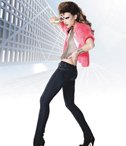Serfontaine Turns to Technology and Fabric to Perfect Fit
In the premium-denim market, the ongoing question tends to be what’s next? For Los Angeles–based designer Mik Serfontaine, the answer lies in fabric innovation and the technology of fit. Sefontaine’s mantra for the season is “The Shape of Things to Come,” a concept illustrated in the company’s futuristic rock ’n’ roll lookbook for Fall 2010. “Serfontaine has embraced the futuristic type of thing not just because it’s a novelty look for us or because we have a vision to be some kind of a ’Blade Runner’ type of brand,” Serfontaine said. “But it’s based on this foundation of building a better jean. Isn’t that what premium is about?” Fueled by a love for denim itself and the desire to create a better product, Serfontaine and his wife, Maria, have been developing the collection since the brand launched in 2000. They were one of the first to use organic standards for washes and helped test fit Invista’s XFIT Lycra fabric technology.
“Mik was one of the first ones to introduce [XFIT] into the market, and he was literally one of the first ones who was making garments with it. We worked very closely together from a technical standpoint as well as a marketing standpoint. He was very much on the forefront of the whole XFIT project,” said Jean Hegedus, Invista’s global marketing director for denim and bottoms. In addition, the designing duo is working with United Kingdom–based Bodymetrics to perfect the company’s body-scanning service. Serfontaine foresees selling perfectly fit denim to online shoppers in the near future and has plans to bring the body-scanner technology to a major retailer in the United States. Virtual shopping, XFITs and avatars may sound like something out of a sci-fi movie, but for Serfontaine this is reality. Fashion Editor N. Jayne Seward caught up with Serfontaine to talk denim, technology and the future of premium denim.
What is the design philosophy of Serfontaine?
M.S. Serfontaine is very interested in where denim is going and driving it forward. How do you drive denim forward? Because [we are working with jeans], we are working in a limited realm of what we can do. We’re not going to put a third leg on a pair of jeans, so we’ve really taken to seeing what can be done with fabric technology.
What are some of the advancements you have made with fabric technology?
M.S. We were one of the first brands to really start working with new stretch fibers. As far back as 2003 or 2004, we started working with a new [Lycra] stretch fiber called T400, which back then was brand-new. It only came out in 2002. T400 really was the next generation of stretch fiber that Invista invented because, we all know, especially you, ladies, that when you put on a pair of stretch jeans—no matter whether it’s premium or not—the initial fit is good, but it starts bagging out on you in about an hour. So we adopted T400 because it has the best recovery of the denim stretch fibers. It doesn’t bag out on you, so it really holds its fit.
What is your main focus in creating a pair of jeans?
M.S. Our focus has always been on the fit because, at the end of the day, no matter how cool the brand is or how cool your line is, a woman has to base her purchase on whether she feels the jean meets her [standards]. She’s going to say, “Hey, do I look good in it?”
How are you improving the fit of a jean?
M.S. A lot of companies say they have the best-fitting jean, but really fit is relative to your body shape. A woman’s shape might be different from the fit model that was used for that particular denim company. So that jean wouldn’t fit you no matter how good that fit is on the fit model. We’ve been trying to find ways to accommodate more body shapes. And that comes through advancing stretch technology.
How have you advanced stretch technology?
M.S. We were the first worldwide partner to launch XFIT Lycra, and I truly really believe bi-stretch is the future of premium denim right now because of its ability to fit a much wider range of body shapes than any regular [spandex] could hope to do. The T400 XFIT is probably the most advanced denim you can get on the market in terms of keeping its shape and fitting more people and comfort. Women want to be comfortable and sexy, and I don’t think they have to give up either. A lot of times they do because if they want to wear something that’s super-skinny and tight, they are going to have to buy it a size smaller because it’s going to stretch out. I don’t believe you have to give up any of those attributes. If you’re going to be dropping $200 on a pair of jeans, why can’t you have it all? That’s the whole XFIT element to our brand. We have a whole core collection of basics and obviously all the fashion pieces. It’s all got XFIT in it, so no matter what you wear from Serfontaine, it’s going to have the four-way stretch. We also do amazing things to the fabric in terms of washes in our core collection. We can rip it and break it and all sorts of things.
Explain how the Bodymetrics service developed.
M.S. In collaboration with Selfridges London, we are incorporating a body scanner for jeans. Selfridges has the largest denim bar in Europe. We have about 400 square feet [in there], where we have a body scanner that we have been using and tweaking for the past four or five years. We use the body scanner for many different reasons, but No. 1, we can capture your scan and we can tell you what shape you are. A lot of women are confused as to why jeans fit them and why they don’t. You go in a dressing room with 12 or 15 pairs from maybe as many different brands. Sometimes you are size 27 and sometimes a size 26. You can be a curvy size 24 or a curvy size 33. It’s your bone structure; it’s not how heavy you are.
How does the Bodymetrics service work?
M.S. We’ve scanned over 20,000 women in London, and we’ve built quite a nice database of exactly what’s going on in terms of women’s body shapes and what category they fall. So we can very easily tell you if we scan you: “This is what’s going to fit you.” We have all these different shapes pre-made because we already know what a woman’s body shapes are. So you don’t have to mess around with fit, you just have to decide what silhouette you want. Do you want a skinny, do you want a boot, do you want a straight, do you want a peg, do you want light, dark? So we take that element out of it and we demystify the fitting process for people, and it has made us theNo. 1 selling brand at Selfridges. We did over $1 million in retail sales out of 400 square feet last year.
What made you choose to test the scanner at Selfridges?
M.S. The hardware-scanning company is a German company. The software technology is a U.K. company, so we’ve teamed up with them. The technology is based out of Europe, but those companies approached a lot of the U.S.-based denim companies to partner up with them. We quickly got what they were talking about. We said, “Where do we sign? Let’s get going.”
How long have you been developing this technology?
M.S. We’ve been working on it for five years, but we’ve had the luxury of working on it in a retail environment in Selfridges. They have been very patient, and it’s paying off for them now. And we also do it in a retail model that is very un-American and un-European—we are a concession in Selfridges. We manage all of our own product there. We don’t deal with the buyer. They set a target for us every year on how much they want us to meet in sales, and we just give them a percentage. ... So we’re kind of left to our own devices, and that’s been great.
How do you see the Bodymetrics service assisting online shoppers in the future?
M.S. When you look at the Internet, shopping is the second-largest generator of revenue online. The biggest problem with Internet shopping is there is no standardized sizing. So what we do is once we have scanned you and we have your avatars—your true avatar, not a rendered approximation of you putting in your sizing and what you think—you can truly shop online. You can try your jeans online virtually, photo-realistically like you really are trying them on. So you can try on a pair of Serfontaine jeans, and once you’ve been scanned, you never have to go back to the store. You can try them online if they are too small, the buttons don’t close on you, or it’s too big and it drapes all funny and it’s not fitting you—you can see that. We are bringing this technology to the States either this year or next year with a major retailer. So that truly is going to be, I think, a watershed moment for denim and online shopping.



























